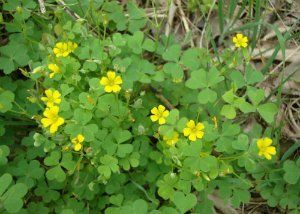Description: Wood Sorrel, scientifically known as Oxalis acetosella, is a perennial herbaceous plant that belongs to the Oxalidaceae family. Recognized for its distinct three-lobed leaves and delicate white to pinkish flowers, Wood Sorrel often carpets woodland floors and shaded areas. Despite its appealing appearance, it is essential to note that some species within the Oxalis genus can become invasive.
Habitat and Distribution: Wood Sorrel thrives in shaded, moist woodlands, meadows, and grassy areas. Native to Europe, Asia, and North America, it has spread to various regions globally. Its ability to adapt to different soil types and climates makes it a common sight in both natural and disturbed environments.
Physical Features: Leaves: The leaves are trifoliate (three-lobed) and resemble the shape of a clover. They fold down at night or during overcast conditions.
Flowers: Wood Sorrel produces delicate, five-petaled flowers that can be white, pink, or tinged with purple. The flowers close during low light or adverse weather conditions.
Invasive Characteristics: While Wood Sorrel is not typically considered highly invasive, some species can spread rapidly, forming dense colonies and outcompeting native vegetation. The plant reproduces through both seeds and underground bulbs, contributing to its ability to colonize new areas.
Control Methods:
- Manual Removal: Hand pulling or digging up Wood Sorrel is effective for small infestations. Be sure to remove the entire plant, including the bulbs, to prevent regrowth.
- Mulching: Applying a layer of organic mulch around desirable plants can help suppress Wood Sorrel growth by blocking sunlight and reducing soil temperature. Mulching also conserves moisture and improves soil health.
- Herbicides: Selective herbicides designed for broadleaf weed control can be used to target Wood Sorrel. Carefully follow application instructions to avoid harm to desirable plants.
- Cultural Practices: Practices such as maintaining a healthy lawn or garden, regular mowing, and avoiding overwatering can create conditions less favorable for Wood Sorrel growth. Promoting a dense turf or garden reduces opportunities for weed establishment.
Preventing Spread:
- Early Detection: Regularly inspecting gardens, lawns, and wooded areas for signs of Wood Sorrel is crucial for early detection. Prompt removal can prevent the spread of seeds and bulbs.
- Improving Soil Health: Enhancing soil health through proper fertilization and pH management can discourage Wood Sorrel growth and promote the success of desirable plants.
Competition with Other Plants:
Planting shade-tolerant ground covers or companion plants can help limit Wood Sorrel spread. Examples include:
- Hostas (Hosta spp.): Form a dense ground cover in shaded areas.
- Ferns (Dryopteris spp.): Thrive in woodland environments, competing with Wood Sorrel for resources.
In conclusion, controlling Wood Sorrel involves a combination of manual, cultural, and, in some cases, chemical control methods. By understanding its growth habits and implementing effective strategies, it is possible to manage and mitigate the impact of Wood Sorrel in various environments.



